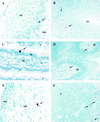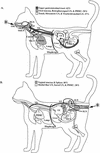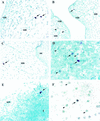Early pathogenesis of transmucosal feline immunodeficiency virus infection
- PMID: 12021364
- PMCID: PMC136212
- DOI: 10.1128/jvi.76.12.6311-6322.2002
Early pathogenesis of transmucosal feline immunodeficiency virus infection
Abstract
To identify the early target cells and tissues in transmucosal feline immunodeficiency virus (FIV) infection, cats were exposed to a clade C FIV isolate via the oral-nasal or vaginal mucosa and multiple tissues were examined by virus isolation coculture (VI), DNA PCR, catalyzed tyramide signal-amplified in situ hybridization (TSA-ISH), and immunohistochemistry between days 1 and 12 postinoculation (p.i.). FIV RNA was detected in tonsil and oral or vaginal mucosa as early as 1 day p.i. by TSA-ISH and in retropharyngeal, tracheobronchial, or external iliac lymph nodes and sometimes in spleen or blood mononuclear cells by day 2, indicating that regional and distant spread of virus-infected cells occurred rapidly after mucosal exposure. By day 8, viral RNA, DNA, and culturable virus were uniformly detected in regional and distant tissues, connoting systemic infection. TSA-ISH proved more sensitive than DNA PCR in detecting early FIV-infected cells. In mucosal tissues, the earliest demonstrable FIV-bearing cells were either within or subjacent to the mucosal epithelium or were in germinal centers of regional lymph nodes. The FIV(+) cells were of either of two morphological types, large stellate or small round. Those FIV RNA(+) cells which could be colabeled for a phenotype marker, were labeled for either dendritic-cell-associated protein p55 or T-lymphocyte receptor antigen CD3. These studies indicate that FIV crosses mucous membranes within hours after exposure and rapidly traffics via dendritic and T cells to systemic lymphoid tissues, a pathway similar to that thought to occur in the initial phase of infection by the human and simian immunodeficiency viruses.
Figures



Similar articles
-
Vaginal and rectal infection of cats with feline immunodeficiency virus.Vet Microbiol. 1996 Aug;51(3-4):217-27. doi: 10.1016/0378-1135(96)00038-7. Vet Microbiol. 1996. PMID: 8870185
-
Relationship of lymphoid lesions to disease course in mucosal feline immunodeficiency virus type C infection.Vet Pathol. 2000 Sep;37(5):386-401. doi: 10.1354/vp.37-5-386. Vet Pathol. 2000. PMID: 11055861
-
Virulence differences between two field isolates of feline immunodeficiency virus (FIV-APetaluma and FIV-CPGammar) in young adult specific pathogen free cats.Vet Immunol Immunopathol. 2001 May 10;79(1-2):53-67. doi: 10.1016/s0165-2427(01)00252-5. Vet Immunol Immunopathol. 2001. PMID: 11356250
-
Mucosal infection and vaccination against feline immunodeficiency virus.J Biotechnol. 1999 Aug 20;73(2-3):213-21. doi: 10.1016/s0168-1656(99)00139-x. J Biotechnol. 1999. PMID: 10486930 Review.
-
Feline APOBEC3s, Barriers to Cross-Species Transmission of FIV?Viruses. 2018 Apr 10;10(4):186. doi: 10.3390/v10040186. Viruses. 2018. PMID: 29642583 Free PMC article. Review.
Cited by
-
HIV-1 and drug abuse comorbidity: Lessons learned from the animal models of NeuroHIV.Neurosci Lett. 2021 May 29;754:135863. doi: 10.1016/j.neulet.2021.135863. Epub 2021 Mar 29. Neurosci Lett. 2021. PMID: 33794296 Free PMC article. Review.
-
Antiretroviral spermicide WHI-07 prevents vaginal and rectal transmission of feline immunodeficiency virus in domestic cats.Antimicrob Agents Chemother. 2004 Apr;48(4):1082-8. doi: 10.1128/AAC.48.4.1082-1088.2004. Antimicrob Agents Chemother. 2004. PMID: 15047505 Free PMC article.
-
Pathogenesis of oral FIV infection.PLoS One. 2017 Sep 21;12(9):e0185138. doi: 10.1371/journal.pone.0185138. eCollection 2017. PLoS One. 2017. PMID: 28934316 Free PMC article.
-
Feline immunodeficiency virus ORF-Ais required for virus particle formation and virus infectivity.J Virol. 2003 Aug;77(16):8819-30. doi: 10.1128/jvi.77.16.8819-8830.2003. J Virol. 2003. PMID: 12885901 Free PMC article.
-
Role of Env in resistance of feline immunodeficiency virus (FIV)-infected cats to superinfection by a second FIV strain as determined by using a chimeric virus.J Virol. 2007 Oct;81(19):10474-85. doi: 10.1128/JVI.01064-07. Epub 2007 Jul 18. J Virol. 2007. PMID: 17634241 Free PMC article.
References
-
- Amerongen, H. M., R. Weltzin, C. M. Farnet, P. Michetti, W. A. Haseltine, and M. R. Neutra. 1991. Transepithelial transport of HIV-1 by intestinal M cells: a mechanism for transmission of AIDS. J. Acquir. Immune Defic. Syndr. 4:760-765. - PubMed
-
- Ayehunie, S., R. W. Groves, A. M. Bruzzese, R. M. Ruprecht, T. S. Kupper, and E. Langhoff. 1995. Acutely infected Langerhans cells are more efficient than T cells in disseminating HIV type 1 to activated T cells following a short cell-cell contact. AIDS Res. Hum. Retrovir. 11:877-884. - PubMed
-
- Baba, T. W., A. M. Trichel, L. An, V. Liska, L. N. Martin, M. Murphey-Corb, and R. M. Ruprecht. 1996. Infection and AIDS in adult macaques after nontraumatic oral exposure to cell-free SIV. Science 272:1486-1489. - PubMed
-
- Bach, J. M., M. Hurtrel, L. Chakrabarti, J. P. Ganiere, L. Montagnier, and B. Hurtrel. 1994. Early stages of feline immunodeficiency virus infection in lymph nodes and spleen. AIDS Res. Hum. Retrovir. 10:1731-1738. - PubMed
Publication types
MeSH terms
Substances
Grants and funding
LinkOut - more resources
Full Text Sources
Research Materials
Miscellaneous

